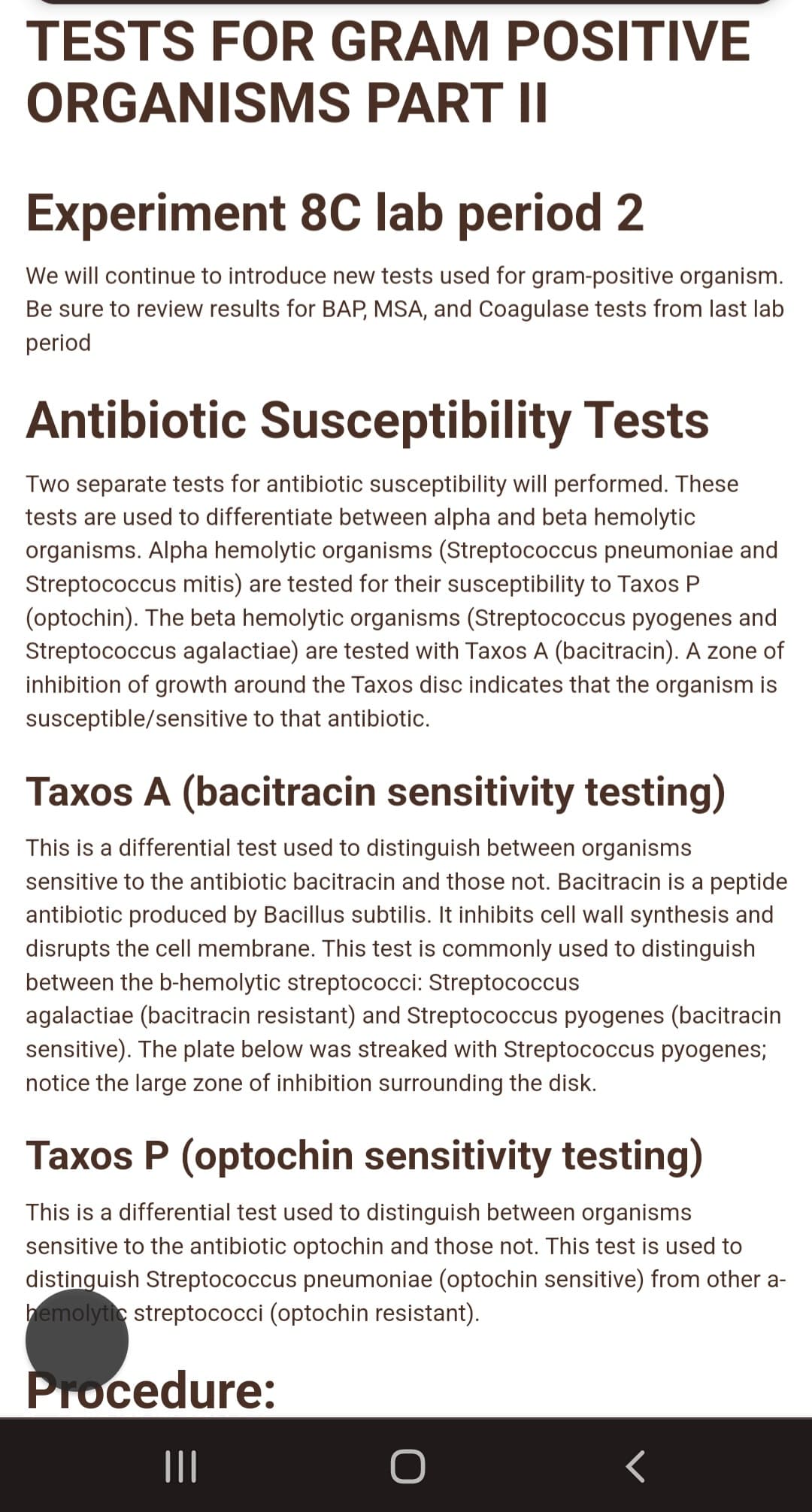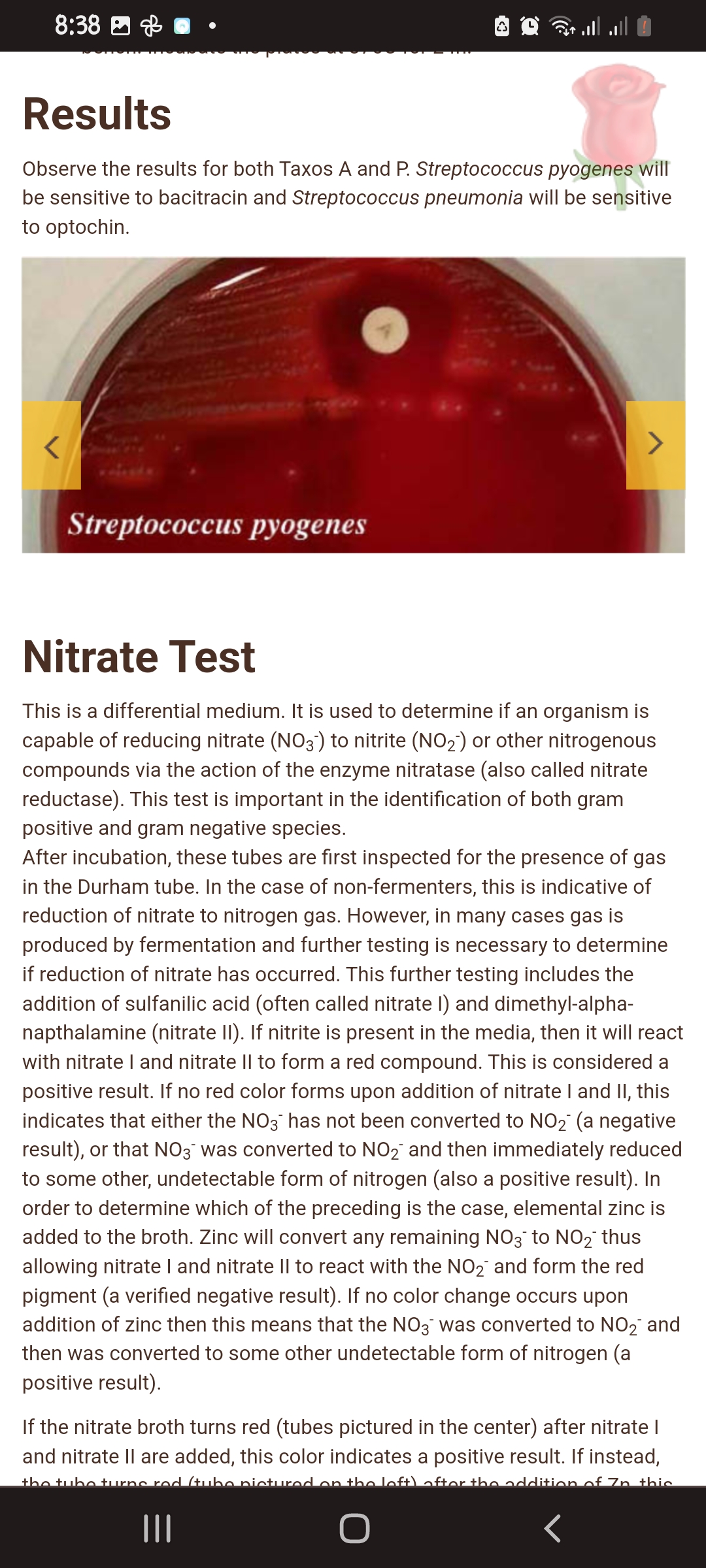TESTS FOR GRAM POSITIVE ORGANISMS PART II Experiment 8C lab period 2 We will continue to introduce new tests used for gram-positive organism. Be sure to review results for BAP, MSA, and Coagulase tests from last lab period Antibiotic Susceptibility Tests Two separate tests for antibiotic susceptibility will performed. These tests are used to differentiate between alpha and beta hemolytic organisms. Alpha hemolytic organisms (Streptococcus pneumoniae and Streptococcus mitis) are tested for their susceptibility to Taxos P (optochin). The beta hemolytic organisms (Streptococcus pyogenes and Streptococcus agalactiae) are tested with Taxos A (bacitracin). A zone of inhibition of growth around the Taxos disc indicates that the organism is susceptible/sensitive to that antibiotic. Taxos A (bacitracin sensitivity testing) This is a differential test used to distinguish between organisms sensitive to the antibiotic bacitracin and those not. Bacitracin is a peptide antibiotic produced by Bacillus subtilis. It inhibits cell wall synthesis and disrupts the cell membrane. This test is commonly used to distinguish between the b-hemolytic streptococci: Streptococcus agalactiae (bacitracin resistant) and Streptococcus pyogenes (bacitracin sensitive). The plate below was streaked with Streptococcus pyogenes; notice the large zone of inhibition surrounding the disk. Taxos P (optochin sensitivity testing) This is a differential test used to distinguish between organisms sensitive to the antibiotic optochin and those not. This test is used to distinguish Streptococcus pneumoniae (optochin sensitive) from other a- hemolytic streptococci (optochin resistant). Procedure:
TESTS FOR GRAM POSITIVE ORGANISMS PART II Experiment 8C lab period 2 We will continue to introduce new tests used for gram-positive organism. Be sure to review results for BAP, MSA, and Coagulase tests from last lab period Antibiotic Susceptibility Tests Two separate tests for antibiotic susceptibility will performed. These tests are used to differentiate between alpha and beta hemolytic organisms. Alpha hemolytic organisms (Streptococcus pneumoniae and Streptococcus mitis) are tested for their susceptibility to Taxos P (optochin). The beta hemolytic organisms (Streptococcus pyogenes and Streptococcus agalactiae) are tested with Taxos A (bacitracin). A zone of inhibition of growth around the Taxos disc indicates that the organism is susceptible/sensitive to that antibiotic. Taxos A (bacitracin sensitivity testing) This is a differential test used to distinguish between organisms sensitive to the antibiotic bacitracin and those not. Bacitracin is a peptide antibiotic produced by Bacillus subtilis. It inhibits cell wall synthesis and disrupts the cell membrane. This test is commonly used to distinguish between the b-hemolytic streptococci: Streptococcus agalactiae (bacitracin resistant) and Streptococcus pyogenes (bacitracin sensitive). The plate below was streaked with Streptococcus pyogenes; notice the large zone of inhibition surrounding the disk. Taxos P (optochin sensitivity testing) This is a differential test used to distinguish between organisms sensitive to the antibiotic optochin and those not. This test is used to distinguish Streptococcus pneumoniae (optochin sensitive) from other a- hemolytic streptococci (optochin resistant). Procedure:
Microbiology for Surgical Technologists (MindTap Course List)
2nd Edition
ISBN:9781111306663
Author:Margaret Rodriguez, Paul Price
Publisher:Margaret Rodriguez, Paul Price
Chapter6: Microbial Viability And Growth
Section: Chapter Questions
Problem 4UTM
Related questions
Question
This expiremwnt was carried out .
In no less than 30 words what can uconcluded from this lab

Transcribed Image Text:TESTS FOR GRAM POSITIVE
ORGANISMS
PART II
Experiment 8C lab period 2
We will continue to introduce new tests used for gram-positive organism.
Be sure to review results for BAP, MSA, and Coagulase tests from last lab
period
Antibiotic Susceptibility Tests
Two separate tests for antibiotic susceptibility will performed. These
tests are used to differentiate between alpha and beta hemolytic
organisms. Alpha hemolytic organisms (Streptococcus pneumoniae and
Streptococcus mitis) are tested for their susceptibility to Taxos P
(optochin). The beta hemolytic organisms (Streptococcus pyogenes and
Streptococcus agalactiae) are tested with Taxos A (bacitracin). A zone of
inhibition of growth around the Taxos disc indicates that the organism is
susceptible/sensitive to that antibiotic.
Taxos A (bacitracin sensitivity testing)
This is a differential test used to distinguish between organisms
sensitive to the antibiotic bacitracin and those not. Bacitracin is a peptide
antibiotic produced by Bacillus subtilis. It inhibits cell wall synthesis and
disrupts the cell membrane. This test is commonly used to distinguish
between the b-hemolytic streptococci: Streptococcus
agalactiae (bacitracin resistant) and Streptococcus pyogenes (bacitracin
sensitive). The plate below was streaked with Streptococcus pyogenes;
notice the large zone of inhibition surrounding the disk.
Taxos P (optochin sensitivity testing)
This is a differential test used to distinguish between organisms
sensitive to the antibiotic optochin and those not. This test is used to
distinguish Streptococcus pneumoniae (optochin sensitive) from other a-
hemolytic streptococci (optochin resistant).
Procedure:
|||
O

Transcribed Image Text:8:38
Results
Observe the results for both Taxos A and P. Streptococcus pyogenes will
be sensitive to bacitracin and Streptococcus pneumonia will be sensitive
to optochin.
Streptococcus pyogenes
Nitrate Test
This is a differential medium. It is used to determine if an organism is
capable of reducing nitrate (NO3-) to nitrite (NO₂) or other nitrogenous
compounds via the action of the enzyme nitratase (also called nitrate
reductase). This test is important in the identification of both gram
positive and gram negative species.
After incubation, these tubes are first inspected for the presence of gas
in the Durham tube. In the case of non-fermenters, this is indicative of
reduction of nitrate to nitrogen gas. However, in many cases gas is
produced by fermentation and further testing is necessary to determine
if reduction of nitrate has occurred. This further testing includes the
addition of sulfanilic acid (often called nitrate I) and dimethyl-alpha-
napthalamine (nitrate II). If nitrite is present in the media, then it will react
with nitrate I and nitrate II to form a red compound. This is considered a
positive result. If no red color forms upon addition of nitrate I and II, this
indicates that either the NO3 has not been converted to NO₂ (a negative
result), or that NO3¯ was converted to NO₂ and then immediately reduced
to some other, undetectable form of nitrogen (also a positive result). In
order to determine which of the preceding is the case, elemental zinc is
added to the broth. Zinc will convert any remaining NO3 to NO₂ thus
allowing nitrate I and nitrate II to react with the NO₂ and form the red
pigment (a verified negative result). If no color change occurs upon
addition of zinc then this means that the NO3 was converted to NO₂ and
then was converted to some other undetectable form of nitrogen (a
positive result).
If the nitrate broth turns red (tubes pictured in the center) after nitrate I
and nitrate II are added, this color indicates a positive result. If instead,
the tube turne rod (tubo pictured on the left) after the addition of In this
|||
Expert Solution
This question has been solved!
Explore an expertly crafted, step-by-step solution for a thorough understanding of key concepts.
This is a popular solution!
Trending now
This is a popular solution!
Step by step
Solved in 2 steps

Knowledge Booster
Learn more about
Need a deep-dive on the concept behind this application? Look no further. Learn more about this topic, biology and related others by exploring similar questions and additional content below.Recommended textbooks for you

Microbiology for Surgical Technologists (MindTap …
Biology
ISBN:
9781111306663
Author:
Margaret Rodriguez, Paul Price
Publisher:
Cengage Learning


Microbiology for Surgical Technologists (MindTap …
Biology
ISBN:
9781111306663
Author:
Margaret Rodriguez, Paul Price
Publisher:
Cengage Learning
